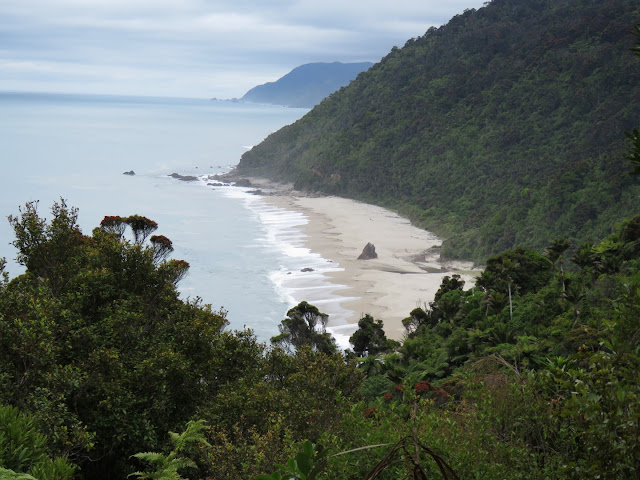One of our three chosen Great Walks that we had wanted to do, the Abel Tasman Coast Track, in Abel Tasman National Park, was fully booked. It was an 'easy' track, level, sandy and involving many beaches. We were disappointed when we couldn't get on it. Like the Milford Track, it probably needs to be booked a year in advance. We've wanted to try sea kayaking for a while now and there are nine companies offering various trips and tours through the park. Realizing that these commercial operations would have already pre-booked their campsites, we would therefore still be able to visit the park if we signed up for one of their tours. So, we did. We were able to get on a three day tour with the Sea Kayak Company (
http://www.seakayaknz.co.nz/), out of Motueka, during the first week of January. It was a small group, two Germans, a US family of three and our guide, Ethan. Just four kayaks in all.

Although the trip wasn't without weather challenges, it was a great choice of company. All food (delicious and lots of it), transport and equipment was provided. First day, we left from Marahou beach, via water taxi, to the northernmost part of our itinerary from where we would paddle back to Marahou over the three days. Our kayaks had already been taken to the start point earlier in the day and we just had to carry all our personal gear and the group's food aboard the taxi. The day was overcast and threatened rain. There was a slight wind in our favour which was good for the first time out. It took a while to get into our stride in the kayak, it's very different from canoeing and seemed very unnatural at first. Due to our past canoe and sail experience, though, we felt comfortable out on the water with the slight swell and waves. We arrived at the first campsite and snagged a prime site for our tent.

There was a nice beach, a forest pool and interesting sea caves to explore here at Onetahuti Bay.
Ethan, our guide, did the cooking and for the first night's "pudding" (dessert), presented us with this great Pavlova, a unique NZ dessert consisting of meringue topped with fresh cream, berries and usually kiwi fruit. This version maybe wouldn't win a beauty contest, having been slightly squashed in the kayak, but, it tasted absolutely delicious and we all enjoyed it very much.
We were entertained in camp by a group of Pukeko. Check out the big feet with extra long toes, which, because they need to be lifted so high for each step, makes them look like they are walking with galoshes on.
We also had a bunch of cheeky wekas to enjoy. These are flightless birds, but, are known to have a mischievous nature and will walk off with campers' possessions if you're not careful.
It started raining overnight and it absolutely poured rain for all of Day Two. The rain dampened the sea, so, the kayaking was fairly easy, but, we were all miserable by early afternoon and couldn't wait to stop for the day. We visited some beautiful spots along the way, tiny tidal estuaries that you could only reach via kayak and it would have been magical on a good weather day. Unfortunately, we didn't want to linger and in the end, just made a beeline for our next stopping point, Anchorage Bay.
The rain stopped about five p.m., we made a good campfire and once dry, our spirits lifted and we enjoyed a good dinner of vegetable curry. Dessert tonight was a huge chocolate brownie each, smothered in chocolate sauce, whipped cream and strawberries!
Day Three was to be a long paddle back to Marahou. As soon as we turned the first corner we knew we could be in trouble. The wind was 'on the nose' (as it always seems to be when we're sailing also) and the sea was starting to whip up. It was hard going, but, we made it to the last headland where, once we turned, we knew we were done for. The wind was coming at us, steadily, around 25-30 knots. That's no wind for a kayak. We couldn't make progress against it and it started blowing us out to sea and we had to retreat. We rode downwind for a while and decided to try once more. Still no progress was possible. Our instructor radioed in for a water taxi pickup, none was available until four p.m. So, we rode back downwind and tucked into a beautiful, sheltered bay where we put up a tarp, enjoyed a huge picnic lunch and laid on the beach, in the hot sun, until it was time to head back to Anchorage Bay, where we'd left from that morning. The last half-mile into the beach was a struggle, but, the taxi trip back to Marahou was uneventful. We learned later that another group had experienced a capsize and that all the kayakers that were out had needed to get off the water.
So, canoeing, or, kayaking? We like river/estuary travel by canoe and kayak, the next bend is always unknown and intriguing, but, found that kayaking on a large, open sea is a little boring and potentially not much fun when the wind and sea kick up. All in all, a good learning experience and now we know what sea kayaking is like.
Once back to our car, we spotted these horseback riders on one of the many beautiful beaches in the area.
 CONTINUE READING
CONTINUE READING






















































